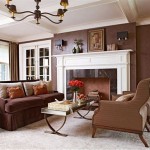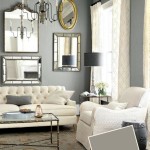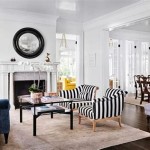Arranging Furniture In A Long Living Room
Long living rooms present unique design challenges. Unlike square or compact spaces, these elongated rooms can easily feel cavernous or disjointed if not properly furnished and arranged. The key to successfully decorating a long living room lies in breaking up the space into distinct zones, optimizing traffic flow, and maximizing both functionality and visual appeal. Proper planning and understanding of design principles are essential to transform a potentially awkward space into a comfortable and inviting environment.
Before any furniture is moved, it is crucial to assess the room's inherent characteristics. The length and width dimensions will obviously dictate potential layout options. The location of doors, windows, fireplaces, and electrical outlets are equally important considerations. Natural light sources significantly impact how the room feels and functions, influencing furniture placement and color palettes. The intended use of the room should also be clearly defined. Will it primarily serve as a space for entertainment, relaxation, or a combination of both? Answering these questions will guide the selection and arrangement of furniture to best suit the occupants' needs.
Defining Functional Zones
The most common strategy for arranging furniture in a long living room is to divide the space into multiple functional zones. This approach prevents the room from feeling like a single, extended hallway and creates distinct areas for different activities. Consider the overall layout of the house and how the living room connects to adjacent spaces. This will help to determine the most logical placement for each zone. Common zone designations include a conversation area, a media center or entertainment zone, a reading nook, and even a small home office if space allows.
The conversation area is typically the focal point of the living room. It should be designed to encourage interaction and comfortable seating. A sofa, armchairs, and a coffee table are essential elements. The size and configuration of these pieces will depend on the overall dimensions of the zone and the desired seating capacity. Arranging furniture in a cohesive group, facing each other if possible, promotes conversation. Avoid placing furniture against the walls, as this can make the room feel even longer and less inviting. Instead, float the furniture to create more intimate groupings.
The media center or entertainment zone often revolves around a television or entertainment console. The placement of this zone should be determined by viewing distance and minimizing glare from windows. Comfortable seating options, such as a sofa, sectional, or comfortable chairs, are essential. Consider incorporating storage solutions for media components and accessories. Positioning the television on a different wall than the main seating area can also create a visual break in the long space.
A reading nook provides a quiet and relaxing space for individual activities. A comfortable armchair, a floor lamp, and a small side table are typically sufficient. Placing the reading nook near a window with natural light is ideal. Consider using a screen or bookshelf to create a sense of enclosure and privacy. The reading nook can also serve as a transition zone between other functional areas.
Optimizing Traffic Flow
Efficient traffic flow is paramount in a long living room. The arrangement of furniture should allow for easy movement between zones and to other areas of the house. Avoid creating obstacles or bottlenecks that impede the natural flow of traffic. Consider the placement of doorways and hallways when planning the furniture layout. Creating clear pathways that are at least 3 feet wide is generally recommended.
Anchoring furniture pieces with area rugs can help define pathways and create visual separation between zones. Rugs should be large enough to encompass the entire seating area or functional zone. Smaller rugs can be used to highlight specific features, such as a coffee table or a reading chair. The strategic placement of rugs can also guide traffic flow and prevent people from cutting across the middle of the room.
Consider the placement of lighting fixtures when planning traffic flow. Overhead lighting, such as chandeliers or pendant lights, can help illuminate pathways. Floor lamps and table lamps can also be used to provide ambient lighting and highlight specific areas. Well-lit pathways enhance safety and make the room feel more inviting.
Creating Visual Interest and Balance
Long living rooms can sometimes feel monotonous if not properly decorated with visual interest and balanced arrangements. Using a variety of shapes, sizes, and textures can help break up the monotony and create a more dynamic and engaging space. Consider incorporating a mix of furniture styles, artwork, and accessories to add personality and character to the room.
Varying the height of furniture pieces can create a more visually appealing composition. Incorporate tall bookcases, floor lamps, and artwork to balance lower-profile furniture, such as sofas and coffee tables. Layering textures, such as throw pillows, blankets, and rugs, can add depth and dimension to the room. Mixing materials, such as wood, metal, and fabric, can also create a more interesting and tactile environment.
Artwork plays a crucial role in creating visual interest and balance in a long living room. Large-scale artwork can serve as a focal point and help anchor a particular zone. Smaller pieces can be grouped together to create a gallery wall. The placement of artwork should be carefully considered to complement the furniture arrangement and overall design scheme. Mirrors can be used to reflect light and create the illusion of more space, particularly in areas that lack natural light.
Pay attention to color palettes when arranging furniture and accessories. Using a cohesive color scheme can tie the different zones together and create a sense of harmony. Consider using a neutral base color with pops of color in accent pieces. The colors should complement the natural light in the room and create the desired mood. Lighter colors can make the room feel more spacious, while darker colors can create a more intimate and cozy atmosphere.
Strategic use of accessories can also contribute to visual interest and balance. Place decorative objects, such as vases, sculptures, and candles, on shelves, tables, and mantels. Group items in odd numbers for a more visually appealing arrangement. Plants can add life and color to the room and help connect the interior space with the outdoors. The selection and placement of accessories should reflect the homeowner's personal style and create a sense of warmth and welcome.
Ultimately, arranging furniture in a long living room requires careful planning, a keen eye for design, and a willingness to experiment. By dividing the space into functional zones, optimizing traffic flow, and creating visual interest and balance, it is possible to transform a potentially challenging space into a comfortable, stylish, and inviting environment that meets the needs of the occupants.

How To Arrange Furniture In A Long Living Room Setting For Four Interiors

How To Arrange Furniture In A Long Living Room 2025 Grace My Space

7 Tips For Arranging Furniture In A Long Narrow Living Room

10 Tips For Styling Large Living Rooms Other Awkward Spaces The Inspired Room

How To Decorate A Long Or Narrow Living Room Solutions For Tricky Spaces

How To Arrange Furniture In A Rectangular Living Room Setting For Four Interiors

How To Decorate A Long Narrow Living Room

How To Decorate A Long Narrow Living Room Jamie Lundstrom

Ways To Arrange Furniture In A Narrow Living Room Kate Wiltshire Design

How To Arrange Furniture In A Long Living Room 2025 Grace My Space








